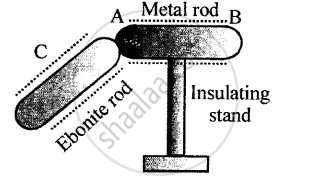Advertisements
Advertisements
Question
Figure below shows a metal rod AB placed on an insulating stand.
In figure (a) a negatively charged ebonite rod C is touched with the metal rod AB, while in figure (b), the negatively charged ebonite rod C is held near the rod AB. State the kind of charges at the ends A and B of the rod, in each case.

Solution
Explanation of Charges:
Case (a): The negatively charged ebonite rod C touches the metal rod AB
- When the ebonite rod C (negatively charged) touches the metal rod AB, electrons are transferred from the ebonite rod to the metal rod because metals are good conductors.
- Charges at the ends:
- End A: Negatively charged (electrons transferred from the ebonite rod).
- End B: Negatively charged (charge spreads evenly across the metal rod).
Case (b): The negatively charged ebonite rod C is held near the rod AB (without touching it)
- In this case, the induction process occurs:
- The negatively charged ebonite rod repels the free electrons in the metal rod AB, causing them to move to the far end (B).
- The end near the ebonite rod (A) becomes positively charged due to the deficiency of electrons.
- The far end (B) becomes negatively charged due to the accumulation of electrons.
APPEARS IN
RELATED QUESTIONS
All metals are insulators of electricity.
If the charge is not in motion, we call it static electricity.
In induction, a positively charged body can make an uncharged body positively charged.
Like charges ............while unlike charges attract.
Match the following
| Column A | Column B |
| A. Two like charges | 1 negative charge |
| B. Two unlike charges |
2 repel |
| C. Silver is a | 3 insulator |
| D. Silk is an | 4 attract |
| E. Ebonite rod rubbed with fur acquires | 5 conductor |
When a glass rod is rubbed with silk, the glass rod and the silk get charged because
What do you understand by electricity at rest?
A glass rod is rubbed with silk. State the kind of charge acquired by each.
An ebonite rod rubbed with fur is suspended near another ebonite rod rubbed with fur. State your observation and give a reason to support your answer.
An ebonite rod is rubbed with fur. Explain the charging of the ebonite rod and the fur on the basis of electron movement.
